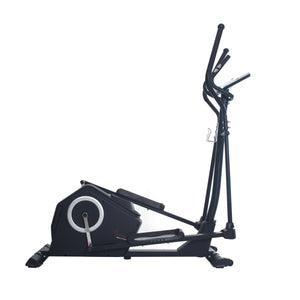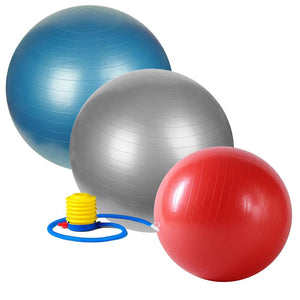Have you ever wondered the best ways determine your current fitness level? While bathroom scales are a dime a dozen, they aren’t the only indicators of your health and fitness.
If you’re looking for a better way to evaluate your health and fitness, we’ve listed 5 reliable tests that you can try before you start an exercise program. While you don’t have to take all of these tests, each one will give you better insight on your individual health and fitness.
Resting Heart Rate & Blood Pressure
Both resting heart rate and blood pressure assessments are tests you can use to determine your heart health. Heart health is an important indicator for overall cardiovascular strength, as well as health risk factors. With exercise, your heart health can improve. You should periodically check your resting heart rate and blood pressure throughout a fitness program to assess your progress.
A lower resting heart rate could mean that you have a healthier and stronger heart. Higher heart rates greater than 100 beats per minute could be a symptom of an underlying issue. Conversely a heart rate that is under 60 beats per minute could be accompanied with dizziness or shortness of breath.
While not as easy to check, blood pressure is a better indicator of your hearts health when compared to your resting heart rate. Having high blood pressure (greater than 120/80) when you start an exercise program could be dangerous. It is strongly recommended to check your resting heart rate and blood pressure as well as consult your doctor before you safely begin any exercise program.
Testing your resting heart rate is a simple assessment that you can do at home. Use the index finger and middle finger of one hand and place them lightly on the area just beneath your thumb on the back side of your wrist. Once you feel your pulse, count the number of heart beats for one minute. The number of beats you count is your resting heart rate (per minute). The best time to test your resting heart rate is right when you wake up in the morning.
To test your blood pressure, you will need a blood pressure monitor. This test should be performed by a doctor, or qualified health or fitness professional.
Body Fat percentage and BMI (Body Mass Index)
Doctors and fitness professionals use BMI to determine healthy weight ranges. To get your BMI you simply perform a calculation based of your height and weight to give you your BMI score.
BMI = (weight in pounds x 703) / (height in inches)
If your BMI is between 18.5 and 25 you are within a healthy weight range. Above 25.0 indicates you are overweight and below 18.5 is considered underweight. Higher than 30 is considered obese.
Generally, your BMI is a good indicator of a healthy weight range. However, the results of the BMI test can be misleading for individuals who carry a large amount of muscle. Muscle is denser than fat, and this can make individual appear heavier and unhealthier on charts.
Body fat percentage is a more accurate way to determine healthy weight ranges. Just like resting heart rate vs. blood pressure, testing body fat percentage requires special equipment, compared to the BMI equation that you can calculate on a computer. Body fat percentage testing can show how much fat weight you are carrying on your body, compared to lean weight (muscle, bones, hair, etc.). High body fat percentages (greater than 32 percent for women and 25 percent for men) are an indicators of poor weight ranges.
It is possible for people to be in the ‘normal’ weight category or have a ‘healthy’ BMI but have an obese body fat percentage. Because of this, “normal weight obesity” is a concern. This could potentially lead ‘normal’ weight individuals to believe that they are healthy, when in fact they could be at increased risk for certain heart and metabolic issues.
Performance Assessments
Flexibility: Sit and Reach
If you are interested in testing your general flexibility, the “sit and reach” test is a simple and effective way to test your flexibility at home. This test helps you determine if you have hamstring and low back tightness that can lead to the development of musculoskeletal injuries or issues over time.
This test is very similar to trying to reach down and touching your toes, but in a seated position on the floor. To perform the test, while seated, with your legs straight in front of you and knees fully extended, reach forward towards your toes. If you can reach your toes or past them then your flexibility is good, if you can’t reach your toes, then you may want to add more stretching of your hips and low back to your current exercise routine.
Strength: Pushups
Attempting to do as many pushups as possible is a common way for exercise enthusiasts to test their upper-body strength and endurance. To perform this test, you attempt as many push-ups as possible without taking a break and keeping good form. Your back should be straight. At the lowest point of your pushups, your chin should touch the ground without your knees or stomach touching the floor.
The results of the pushup test are categorized differently based on your age and gender. For example, if you are a man in your 30s a good score for the maximum number of push-ups you can do with good form would be between 18-21 repetitions. For a woman in her 30’s performing 18-26 modified pushups (knees on the ground) would be considered a good score.
Cardiovascular Strength: 1.5-mile Test and 20-meter shuttle run test
If you are curious about the state of your cardiovascular performance, give one or both of these tests a try. Both the 1.5-mile test and 20-meter shuttle run test, are easy ways to determine Syour cardio strength.
You can perform the 1.5 mile run test by completing 1.5 miles as fast as you can. Your score depends on how long it takes you to complete the activity. Faster times are indicative of healthier cardiovascular systems. For example, a 40-year-old man who runs 1.5 miles in 13 minutes and 3 seconds, would be considered in the 50th percentile for that age group. On the other hand, an excellent score for a male in his 30s would be under 10 minutes.
You can also perform a 20 meter shuttle run by running back and forth between two points, following a specific tempo created by a metronome. You must touch each cone before or by the time the beep sounds. As you continue, the beeping tempo will increase until you can no longer keep up with the tempo. This is a great test to measure aerobic power. The longer performances are correlated with better cardiovascular performances.























